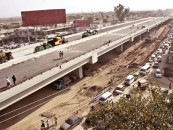Reading between the lines of Pakistan's recovery
The World Bank has pledged a $20 billion, decade-long financing package.

In a recent op-ed appearing in this newspaper, I likened Pakistan's economy to Schrödinger's cat simultaneously alive and dead, depending on the observer's perspective. The analogy, borrowed from quantum theory, captured the ambiguity of a system suspended between two outcomes. Today, that image meets its financial twin: the "dead cat bounce" — a term describing a brief, illusory recovery following a dramatic fall, often misread as the start of a turnaround.
And so, the question arises again: Is Pakistan's economy genuinely rebounding? Or are we mistaking noise for signal?
Following an intense crisis from 2022 and 2024, with historic inflation, record-low reserves and default fears, Pakistan seems to be bouncing back. Headline inflation has plummeted to 0.7% — a 30-year low — foreign exchange reserves have climbed to $15.5 billion, and the IMF has approved a $7 billion bailout, with $1 billion already disbursed.
The World Bank has pledged a $20 billion, decade-long financing package. Investor sentiment has warmed considerably, with Pakistan's global default risk declining by over 90%. Fitch Ratings even upgraded Pakistan's credit rating to B-, the first positive change in years.
These numbers, at first glance, are a sigh of relief. But seasoned observers will note: good statistics don't always equal structural change.
The economy's underlying conditions remain fragile. Growth projections for 2025 are tepid — 3.0% according to the IMF, 2.5% according to the ADB — insufficient for a country with a rapidly expanding population, large informal labour force, and millions living below the poverty line. The short-term uptick is not yet rooted in rising productivity or industrial dynamism; rather, it rides on remittance inflows, external financing, and deferred debt payments.
And the debt burden itself is ominous. Pakistan faces over $22 billion in external repayments this year alone. Much of it will be rolled over - again. While reserves have grown, they are still borrowed, not earned. A spike in oil prices, a geopolitical flare-up, or donor fatigue could bring the illusion crashing down. The economic stabilisation underway is, for now, balancing on a tightrope.
Tax reform remains an unfinished agenda. Despite years of talk about widening the tax base, Pakistan's tax-to-GDP ratio remains below 10%. The energy sector continues to be trapped in inefficiencies and circular debt. Export-led growth has not materialised. Structural bottlenecks remain pervasive, from state-owned enterprises that drain the exchequer to regulatory red tape that chokes entrepreneurship.
Yet, there are flickers of forward motion. The Prime Minister's upcoming package for overseas Pakistanis signals a strategic recalibration — recognising that the diaspora, long tapped only for remittances, could also be a source of investment, tourism, and innovation. A targeted incentives regime for them — eased remittance channels, diaspora bonds, and secure property rights — can generate not just dollars, but trust.
Foreign policy, too, is beginning to reflect an understanding of economic interdependence. Diplomatic engagement between Pakistan and Afghanistan has intensified, with a recent Afghan delegation visiting Islamabad to discuss trade and refugee management, while Pakistan's Deputy Prime Minister Ishaq Dar is currently in Kabul for talks focused on security, transit cooperation, and repatriation.
Meanwhile, Pakistan has urged full cooperation from Tehran after the tragic killing of eight Pakistanis in Iran's Sistan-Baluchestan region. While diplomacy may seem distant from economic growth, in today's interconnected region, peace, and prosperity are inseparable.
All these moves point to a government seeking traction. But the road ahead remains steep. For Pakistan to truly exit the boom-bust cycle, it must adopt an economy-first doctrine that is insulated from electoral timelines and institutional short-termism. That would mean rebuilding state capacity, deregulating selectively, investing in renewable energy and climate resilience, and making growth inclusive — not extractive.
Moreover, the state must do something it has rarely done well — get out of its own way. Let markets work, let merit rise, let small businesses grow. Mobilise the potential of women and youth. Curb elite capture in banking, real estate, and public procurement. Treat digital infrastructure not as a buzzword, but as the foundation of modern governance.
Until these shifts happen, the paradox remains: Pakistan's economy, like Schrödinger's cat, is both alive and at risk. The bounce we are seeing may prove to be just that — a bounce — or it could be the first step of a longer ascent.
For all the warranted scepticism, it is also important not to dismiss the moment entirely. Pakistan has bought itself time. And time, if used wisely, can change trajectories. The signs of life are real, even if the health remains fragile.
So yes, the cat may have bounced. But if it lands on its feet this time, it just might walk again.















COMMENTS (1)
Comments are moderated and generally will be posted if they are on-topic and not abusive.
For more information, please see our Comments FAQ